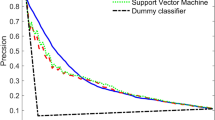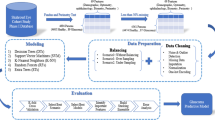Abstract
Medical decision making is based on various diagnostic measurements and the evaluation of anamnestic information. For example glaucoma diagnosis is based on several direct and indirect assessments of the eye. We discuss possibilities to use a definition of glaucoma to improve supervised glaucoma classification by laser scanning image data. The learning sample consists of laser scanning image data and other diagnostic measurements.
We discuss indirect supervised classification proposed by Hand et al. (2001), which provides a framework to incorporate the full information of the learning sample as intermediate variables. We compare direct classifiers like linear discriminant analysis, classification trees and bagged classification trees with indirect classification. Comparing bagged direct and bagged indirect classifiers, we achieve a reduction of estimated misclassification error from 18.3% to 15.4%.
Access this chapter
Tax calculation will be finalised at checkout
Purchases are for personal use only
Preview
Unable to display preview. Download preview PDF.
Similar content being viewed by others
References
Coleman, A. L. (1999): Glaucoma, The Lancet, Vol.354, 1803–10.
Breiman, L. (1996): Bagging predictors, Machine Learning, Vol. 24, 2, 123–140.
Breiman, L. (1998): Arcing classifiers, The Annals of Statistics, Vol. 26, 3, 801 49.
Torgo, L. and Da Costa, J. P. (2000): Clustered multiple regression, in Kiers, H., Rasson, J.-P., Groenen, P., and Schader, M. (Eds.): Data Analysis, Classification, and Related Methods, Springer, Heidelberg, 217–222.
Friedman, J. H. (1997): On bias, variance, 0/1-loss, and the curseofdimensionality, Data Mining and Knowledge Discovery, Vol. 1, 55–77.
Lee, B. L., Bathija, R., and Weinreb, R. N. (1998): The definition of normaltension glaucoma., Journal of Glaucoma, Vol. 7, 6, 366–71.
Cox, D. and Wermuth, N. (1996): Multivariate Dependencies. Models, analysis and interpretation, Chapman Hall, London, UK.
Efron, B. and Tibshirani, R. (1997): Improvements on cross-validation: The.632+ bootstrap method, Journal of the American Statistical Association, Vol. 92, 438, 548–560.
Hand, D., Li, H., and Adams, N. (2001): Supervised classification with structured class definitions, Computational Statistics el Data Analysis, Vol. 36, 209–225.
Swindale, N. V., Stjepanovic, G., Chin, A., and Mikelberg, F. S. (2000): Automated analysis of normal and glaucomatous optic nerve head topography images., Investigative Ophthalmology and Visual Science, Vol. 41, 7, 1730–42.
Mardin, C. Y., Horn, F. K., Jonas, J. B., and Budde, W. M. (1999): Preperimetric glaucoma diagnosis by confocal scanning laser tomography of the optic disc., British Journal of Ophthalmology, Vol. 83, 3, 299–304.
Heidelberg Engineering (1997): Heidelberg Retina Tomograph: Bedienungsanleitung Software version 2.01., Heidelberg Engineering GmbH, Heidelberg.
Lausen, B., Sauerbrei, W., and Schumacher, M. (1994): Classification and regression trees (CART) used for the exploration of prognostic factors measured on different scales, in Dirschedl, P. and Ostermann, R. (Eds.): Computational Statistics, Physica-Verlag, Heidelberg, 483–496.
Ciampi, A. and Lechevallier, Y. (2000): Constructing artificial neural networks for censored survival data from statistical models, in Kiers, H., Rasson, J.-P., Groenen, P., and Schader, M. (Eds.): Data Analysis, Classification, and Related Methods, Springer, Heidelberg, 223–228.
Author information
Authors and Affiliations
Editor information
Editors and Affiliations
Rights and permissions
Copyright information
© 2002 Springer-Verlag Berlin Heidelberg
About this paper
Cite this paper
Peters, A., Hothorn, T., Lausen, B. (2002). Glaucoma Diagnosis by Indirect Classifiers. In: Jajuga, K., Sokołowski, A., Bock, HH. (eds) Classification, Clustering, and Data Analysis. Studies in Classification, Data Analysis, and Knowledge Organization. Springer, Berlin, Heidelberg. https://doi.org/10.1007/978-3-642-56181-8_51
Download citation
DOI: https://doi.org/10.1007/978-3-642-56181-8_51
Publisher Name: Springer, Berlin, Heidelberg
Print ISBN: 978-3-540-43691-1
Online ISBN: 978-3-642-56181-8
eBook Packages: Springer Book Archive




